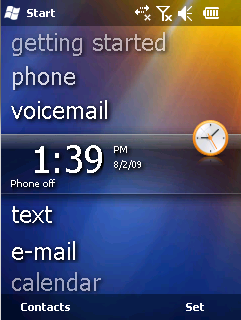The Telephony Application Programming Interface (TAPI) is a Microsoft Windows API, which provides computer telephony integration and enables PCs running Microsoft Windows to use telephone services. Different versions of TAPI are available on different versions of Windows. TAPI allows applications to control telephony functions between a computer and telephone network for data, fax, and voice calls. It includes basic functions, such as dialing, answering, and hanging up a call. It also supports supplementary functions, such as hold, transfer, conference, and call park found in PBX, ISDN, and other telephone systems.

In computing, a windowing system is a software suite that manages separately different parts of display screens. It is a type of graphical user interface (GUI) which implements the WIMP paradigm for a user interface.
Windows Embedded Compact, formerly Windows Embedded CE, Windows Powered and Windows CE, is a discontinued operating system developed by Microsoft for mobile and embedded devices. It was part of the Windows Embedded family and served as the foundation of several classes of devices including the Handheld PC, Pocket PC, Auto PC, Windows Mobile, Windows Phone 7 and others.
Hardware abstractions are sets of routines in software that provide programs with access to hardware resources through programming interfaces. The programming interface allows all devices in a particular class C of hardware devices to be accessed through identical interfaces even though C may contain different subclasses of devices that each provide a different hardware interface.
OpenMAX, often shortened as "OMX", is a non-proprietary and royalty-free cross-platform set of C-language programming interfaces. It provides abstractions for routines that are especially useful for processing of audio, video, and still images. It is intended for low power and embedded system devices that need to efficiently process large amounts of multimedia data in predictable ways, such as video codecs, graphics libraries, and other functions for video, image, audio, voice and speech.
A remote access service (RAS) is any combination of hardware and software to enable the remote access tools or information that typically reside on a network of IT devices.

Windows Mobile is a discontinued mobile operating system developed by Microsoft for smartphones and personal digital assistants.
Networking hardware, also known as network equipment or computer networking devices, are electronic devices that are required for communication and interaction between devices on a computer network. Specifically, they mediate data transmission in a computer network. Units which are the last receiver or generate data are called hosts, end systems or data terminal equipment.
A Bluetooth stack is software that is an implementation of the Bluetooth protocol stack.
In computing, Microsoft's Windows Vista and Windows Server 2008 introduced in 2007/2008 a new networking stack named Next Generation TCP/IP stack, to improve on the previous stack in several ways. The stack includes native implementation of IPv6, as well as a complete overhaul of IPv4. The new TCP/IP stack uses a new method to store configuration settings that enables more dynamic control and does not require a computer restart after a change in settings. The new stack, implemented as a dual-stack model, depends on a strong host-model and features an infrastructure to enable more modular components that one can dynamically insert and remove.

The Huawei E220 is a Huawei HSDPA access device (modem) manufactured by Huawei and notable for using the USB interface.

MS-DOS is an operating system for x86-based personal computers mostly developed by Microsoft. Collectively, MS-DOS, its rebranding as IBM PC DOS, and a few operating systems attempting to be compatible with MS-DOS, are sometimes referred to as "DOS". MS-DOS was the main operating system for IBM PC compatibles during the 1980s, from which point it was gradually superseded by operating systems offering a graphical user interface (GUI), in various generations of the graphical Microsoft Windows operating system.

GraphOn GO-Global is a multi-user remote access application for Windows. GO-Global is a product of GraphOn Corporation.
Halium is a collaborative project to unify the Hardware Abstraction Layer for projects which run Linux on mobile devices with pre-installed Android. The project aims to standardize the middleware software used by various projects to talk with android daemons and make use of hardware on installed devices. It is distributed as free and open-source software under a mix of software licenses.

Phosh is a graphical user interface designed for mobile and touch-based devices and developed by Purism. It is the default shell used on several mobile Linux operating systems including PureOS, Mobian, and Fedora Phosh. It is also an option on postmarketOS, Manjaro, and openSUSE.
The Qualcomm MSM Interface is a proprietary interface for interacting with Qualcomm baseband processors and is a replacement for the legacy cellular extensions of the Hayes command set. With mobile chipsets, communication between the application processor and the baseband processor happens through shared memory. On PCs with data cards, QMI is exposed through USB.





